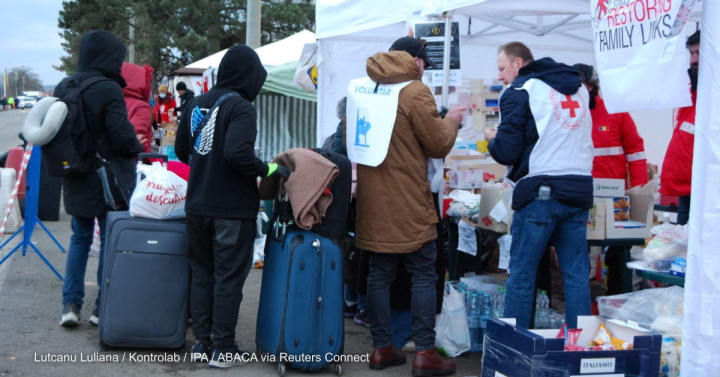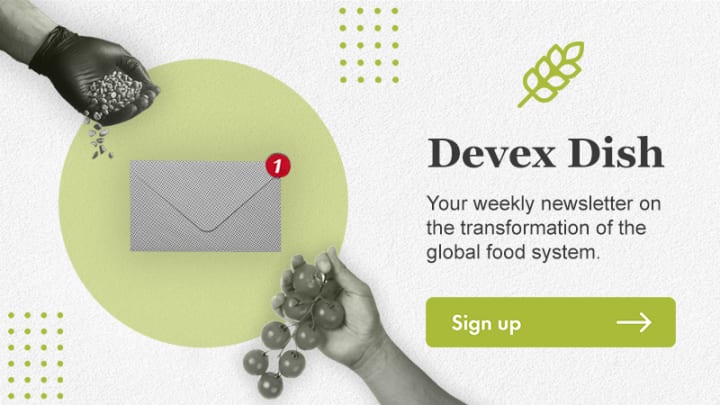
A network of European food banks is mobilizing to provide assistance to hungry people inside Ukraine, as well as refugees who have fled to neighboring countries amid the Russian invasion.
Get the inside track on how agriculture, nutrition, sustainability, and more are intersecting to remake the global food system in this weekly newsletter.
The European Food Banks Federation, or FEBA, is a coalition of over 300 food banks in more than two dozen countries across the continent. Its members have traditionally focused on recovering business operators’ surplus food that would have otherwise gone uneaten and distributing it to food banks and charities to feed hungry people. They also help reduce food waste as a part of their focus on the Sustainable Development Goals.
Now, the work has taken on a new sense of urgency. Grocery stores are closing as food supply chains break down, and millions of Ukrainians are at risk of going hungry as they are displaced from their homes both inside and outside the country.
“This week, two of the main retailers will close all their shops in Ukraine, so the situation will become even more difficult for the citizens that are still in Ukraine,” FEBA Secretary-General Angela Frigo told Devex. “Since the food production in Ukraine stopped a few weeks ago, what we are trying to do as FEBA is coordinate food assistance to our members in Ukraine.”
Food banks in Romania and Poland are sending food to partners in Ukraine, while a new FEBA member in Moldova — which joined after Russia’s invasion on Feb. 24 — is receiving food that is then sent into Ukraine via the Black Sea port city of Odessa. Food is also reaching the Ukrainian cities of Lviv and Chernivtsi.
Needs are vast both inside and outside the country: Russian attacks are cutting off food for civilians and preventing humanitarian corridors for evacuation, and the United Nations estimates almost 6.5 million people have been displaced within the country.
In bordering nations, where the UN Refugee Agency estimates nearly 3.5 million people have fled, FEBA partners are operating temporary distribution centers. They are providing food to refugees in partnership with NGOs such as Caritas Internationalis, leveraging the skills of each organization.
WFP costs up 50% since 2019, with Ukraine set to make matters worse
WFP's operational costs have increased by half since 2019, the agency says, estimating a 60% funding gap for the coming months. Alongside inflationary pressures, the war in Ukraine threatens to cause shortages of agricultural supplies.
“As food banks, we are good in managing food. And so how can we support, in a good way, the Caritas or Red Cross or the other organizations so they can really help the refugees?” Frigo said. “There is this collaboration, but it’s at different levels. … At [the] European level, it's more an overview trying to coordinate … the interventions.”
Compared with food bank partners, commercial transporters have a harder time getting across the Ukrainian border, Frigo said, so shipments into the country are carried in food bank vehicles. There can also be complications with paperwork because Ukraine is not a part of the European Union.
At first, FEBA wasn’t sure if sending food across the border into Ukraine would be feasible after the conflict started. But it conducted a test with a small van and then a truck carrying 30 pallets of food.
“At the moment, the system works. We don’t know what will happen, since Russia has started to attack also western cities,” Frigo said. “This is becoming a bit more difficult. But at the moment, it works without any kind of security problems.”
FEBA is also tracking the movement of Ukrainian refugees via its members further west in Europe, hearing from German and Italian partners that refugees are already registering for food assistance in those countries.
To support its expanded operations, FEBA is receiving monetary donations from across the continent and from the U.S. from people who want to express solidarity with Ukraine, Frigo said. It has raised €3.1 million so far.
In-kind donations are also being offered, but Frigo said FEBA generally prefers monetary donations so that food can be bought locally when possible to avoid transportation costs and delays. This also avoids violating EU regulations regarding labeling food in local languages.
In some cases, FEBA is working with businesses to facilitate food donations amid concerns about inflation and disruptions to supplies of commodities.
The extra funds are sorely needed: FEBA saw an increase of 35% in the people it served amid the COVID-19 pandemic, as well as a 12% increase in the amount of food distributed. The money will help food banks scale up their efforts to meet the new boost in demand from Ukrainian refugees.
“We already had a huge increase during COVID, and now we have this additional increase due to the refugees. It’s really challenging because the refugees are on the top of traditional beneficiaries that we were already assisting,” Frigo said.
“We want to support as many people as possible without any kind of discrimination. This is really a challenge because it means at the moment they are speaking of 10 million refugees from Ukraine,” Frigo continued. “So it potentially could mean that in addition to our traditional 13 million people in need, we have also 10 million refugees from Ukraine. Most are women with babies or with children, so they are for sure a group at risk that will need support in the future.”





